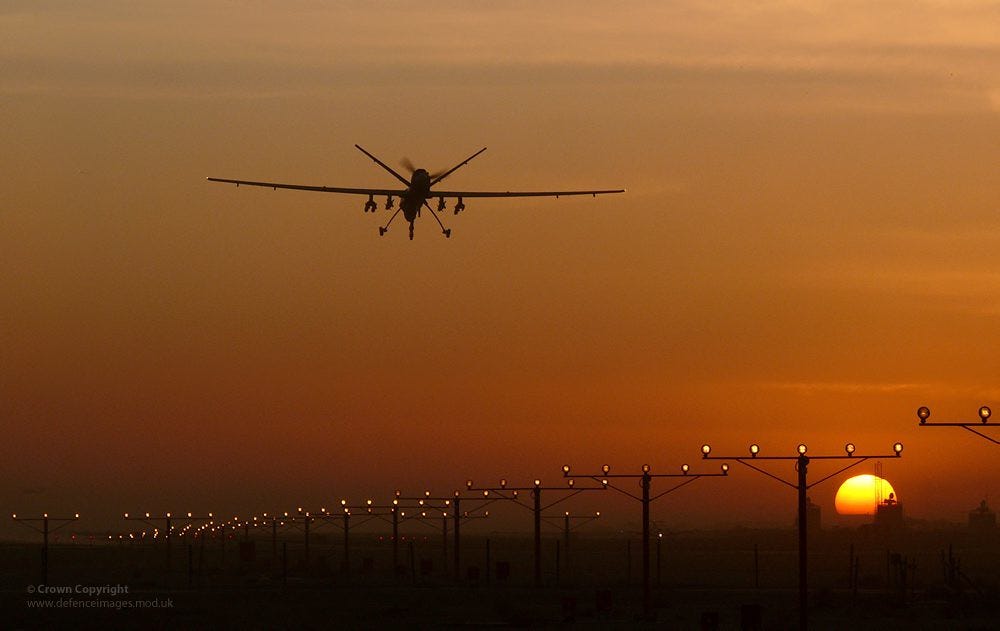
On February 4, 2002, near Khost in southeastern Afghanistan, U.S. forces killed a “tall man” in a case of mistaken identity that revealed core illusions of United States intervention in Afghanistan: a mistaken confidence in modern weapons, excessive faith in intelligence, and the illusion that something was true just because we wanted it to be.
What actually happened: Three men, Daraz Khan (about 31), Jehangir Khan (about 28), and Mir Ahmed (about 30), went to collect scrap metal. As they stood at a site in the mountains at about 10,000 feet, they encountered sudden death from above—a Hellfire missile fired from a predator drone.
What was supposed to have happened? Daraz Khan was tall, and Osama bin Laden, then on the run, was tall (actually taller), so U.S. forces on the hunt for bin Laden apparently killed Khan and the two men with him because drone operators possibly mistook Khan for bin Laden or thought there was a good enough chance he was bin Laden, and the two others had the misfortune to be standing near him.
The killing exposed three illusions that persisted throughout nearly 20 years of U.S. intervention. First, modern weapons, no matter how accurate, might not yield desired outcomes. The drone strike accomplished nothing in this case other than killing three innocent men. Second, modern surveillance, no matter how detailed, does not guarantee that personnel understand what they see. If drone operators thought Daraz Khan was bin Laden, he was not.
The third illusion was perhaps the most powerful: rather than admit failure, the U.S. often attempted to manufacture a more convenient reality. Locals scoffed at the notion that bin Laden was dead, and as it became evident the United States shot someone else, Pentagon officials still defended the strike, suggesting the men had been up to no good. “There are no initial indications that these were innocent locals,” Pentagon spokesman Rear Admiral John Stufflebeam declared. “The indicators were there that there was something untoward that we needed to make go away.” Pentagon Spokeswoman Victoria Clarke said: “We’re convinced that it was an appropriate target,” even though she conceded, “we do not know yet exactly who it was.”
These early killings faded from public memory, at least in the United States, but the early illusions never disappeared. Advanced weaponry and training gave American and NATO forces an edge, but did not provide a path to victory. Despite some intelligence successes, most notably locating and killing bin Laden in 2011, the U.S. and allies could not kill so precisely as to avoid more deaths like Daraz Khan’s.
Even as Americans grew increasingly detached from the war, U.S. and allied airstrikes continued. And some killed civilians, either from erroneously bombing non-military targets or as collateral damage the U.S. accepts as an unavoidable price of attacking militants. Drones tend to kill fewer civilians than alternative methods of striking targets, but that’s little comfort to anyone who lost a family member, friend, or neighbor.
Under President Donald Trump, the U.S. relaxed rules of engagement that sought to avoid civilian casualties, leading to a 330 percent increase in Afghanistan. In 2019 alone, U.S. airstrikes killed 700 Afghan civilians, more than in any other year.
The efforts to manufacture reality evident after the killing of Daraz Khan continued as war dragged on without ever approaching anything the United States could call victory. Warning signs abounded, but military and political leaders, pundits, and some foreign policy “experts” repeatedly touted imagined progress.
In September 2007, General Dan McNeill, Commander of the NATO-led International Security Assistance Force (ISAF) in Afghanistan said he saw “great progress and significant gains in the Afghan National Army.” In April 2008, he predicted that “by about 2011 there is going to be some pretty good capacity in the Afghan National Army.”
By 2009, it was Defense Secretary Robert Gates’s turn for optimism. Lauding what he saw as a Pakistani offensive against the Taliban, Gates told Congress that the possibility of Afghan-Pakistani cooperation “has given me more optimism than I’ve had in a long time in Afghanistan.” The optimistic mood was infectious enough to sway New York Times columnist David Brooks on a 2009 visit in which he determined that the Afghans “detest the insurgents and root for American success.”
America’s supposed success continued: In 2010, General Stanley A. McChrystal, senior commander in Afghanistan, said, “we have made significant progress in setting the conditions in 2009.”
In a January 2011 letter to the International Security Assistance Force, General David Petraeus, who had replaced McChrystal, wrote that the force and its Afghan allies had “made impressive gains in our mission.” He spoke of “hard-won progress … in Helmand and Kandahar provinces.”
Along with making progress, the United States and allies also turned corners. In 2011, President Barack Obama stated the U.S. had “turned a corner,” and Defense Secretary Gates said that, if Afghan forces hold gains, “we can say we’ve turned a corner here in Afghanistan.” Gates’s successor as defense secretary, Leon Panetta, concluded in 2012: “we have turned the corner.”
After Obama’s supposedly-corner-turning troop surge drew down in 2014, the Taliban went on the offensive. In 2017, the Trump administration added more U.S. forces to Afghanistan, leading General John Nicholson to declare that the U.S. and Afghan allies “have turned the corner.” Nicholson hailed the Trump administration plan to place U.S. troops back into combat alongside Afghan forces as a “game-changer” that would make the Taliban “reconcile, face irrelevance, or die.”
In a surprise visit to Afghanistan in late December 2017, Vice President Mike Pence told troops at Bagram Air Base, “I believe victory is closer than ever before.”
Over time, the repeated talk of progress, optimism, turning corners, and victory acquired a fantastical quality. Former Chair of the Joint Chiefs of Staff, Admiral Mike Mullen, was one of the few to publicly acknowledge error: “I thought we could turn it around, obviously, I was wrong,” he acknowledged in 2021.
In August 2021, as the Afghan government rapidly collapsed, so too did the illusions of progress and corner-turning. But another drone strike, the last of the U.S. occupation, showed the same illusions evident nearly 20 years before.
On August 26, an ISIS suicide bomb attack just outside Kabul’s airport tragically killed 169 Afghans and 13 U.S. servicemembers. In response, the U.S. launched a drone strike that killed someone the U.S. called an “ISIS-K planner,” with no known civilian casualties. Then on August 29, the U.S. launched another drone strike in Kabul, reportedly killing more would-be suicide bombers. Subsequent investigations showed the missile had actually blown up a Toyota Corolla driven by Zamari Ahmadi, a 43 year-old who worked at Nutrition and Education International, an American aid group, killing 10 civilians, including 7 children.
Had the U.S. struck a vehicle prepared by suicide bombers? Were the other deaths the result of secondary explosions, indicating the vehicle was bomb as U.S. officials suggested? Or was it another case of bad intelligence? As with the killing of Daraz Khan in 2002, it appears that U.S. analysts misinterpreted Ahmadi’s behavior, launching a missile because it looked like he may have been a terrorist, even though closer examination following his death shows he wasn’t. Then, on September 17, the Pentagon conceded error.
After nearly 20 years of a war of illusions, it’s hard to determine what, if anything, the U.S. had achieved. We had learned nothing from the killing of the tall man.











